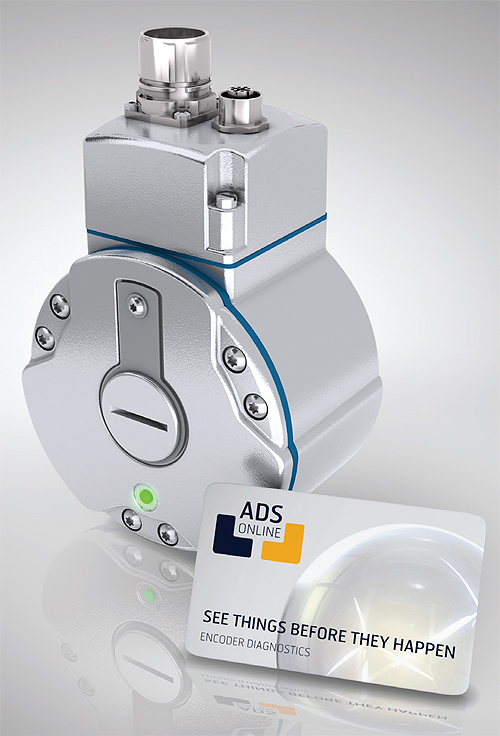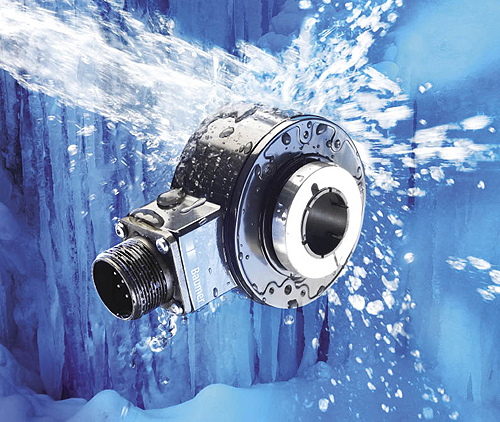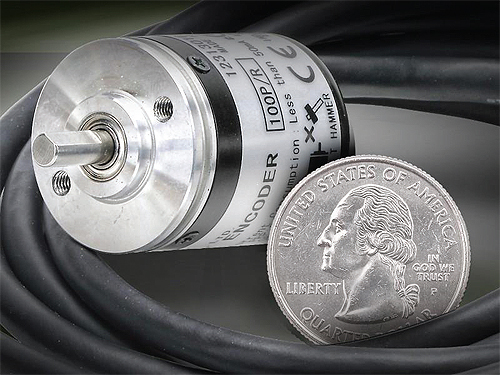by Miles Budimir, Senior Editor
Encoders for position feedback may be a well-established technology, but manufacturers continue to innovate by stretching the application space and adding new, useful features.
Encoders are a well-established technology within the industrial world. Used wherever motion is found, they may not be as glamorous as either the end products or the motors that do the actual moving or the powerful controllers that run the algorithms that control these systems, nevertheless they are a critical part of any successful motion control system.
While the underlying sensing technology (either optical or magnetic) is also well established, manufacturers continue to innovate in other ways. These include new and improved diagnostic capabilities, simplified interfacing to external components and systems, as well as expanding the size and range options that are available.
Interfaces
Encoder manufacturers are making it easier to integrate their encoders with other companies’ components. An example of this comes from HEIDENHAIN, with its new ROC 400 Series rotary encoders that now connect directly to Fanuc controls with alpha or alpha-i interface. The encoders are available with hollow or solid shaft options in single-turn and multi-turn configurations.
The ROC/ROQ 400F rotary encoders for separate shaft coupling feature integral bearings and a solid shaft. The shaft coupling relieves the encoder bearing of any additional loads that could shorten the service life.
The applications for these encoders are typically in machine tools, for instance for use on individual servo axes, spindles, or in functional safety applications where the shaft or stator coupling could break.
The encoders interface with Fanuc 05 serial interface with alpha or alpha-i mode and offer IP 67 protection on the housing and IP 64 on the cable inlet. On the measurement side, they offer up to 25 bits of resolution with maximum velocities up to 15,000 rpm.
The benefits to designers are many, including direct integration making it easier to plug and play, as well as a reduction in engineering design time and effort.
Diagnostic tools
Another area where encoder manufacturers have made progress (and continue to make progress) is in diagnostic capabilities for encoders. Such capabilities allow for preventive maintenance and can eliminate or greatly reduce the costly downtime from unexpected repairs and delays.
Encoder manufacturer Leine and Linde has recently updated their Advanced Diagnostic System (or ADS) encoder diagnostic tool. The new ADS Online is the company’s proprietary advanced encoder diagnostic tool, which is designed to support condition-based maintenance. The system analyzes rotary encoder condition and warns of impending faults before they occur. This is especially useful in large complex machinery such as that used in the exploration of oil & natural gas as well as wind turbines and paper-converting machines. It allows for service to be performed only when necessary and in ample time to avoid unforeseen stops in production.

Factors that can affect service life include temperature, operating speed, and vibration. Because encoders are subject to wear (service life can vary from a couple of years to a couple of decades), an ADS Online system allows users to better predict and schedule maintenance at convenient times instead of waiting for inopportune breakdowns.
Currently available on Leine & Linde’s model 801 and 803 rotary encoders, ADS Online operates by a connection from the encoder’s diagnostic system direct to a PC or to an Ethernet network which provides access to encoder functions or trends anywhere worldwide. With software assistance, users can also obtain detailed analyses. There are also plans to offer ADS Online on other Leine & Linde encoder models in the near future.
Encoder applications for ADS Online include the ability to set custom warnings to ensure vibration doesn’t exceed specific damaging levels, program levels for frequency and shaft speeds to indicate overspeed or standstills, ensuring that the machine does not overheat, preventing voltage drops in the power supply, and choosing to receive an automatic warning when the encoder reaches a certain operating time.
From Heavy to Light Duty
Many applications involve harsh environmental conditions such as extreme temperatures, humidity, pressure and shock and vibration. A standard encoder designed for light industrial environments stands little chance of reliable operation for any long period of time, where the useful life, to borrow some Hobbesian imagery, may be nasty, brutish, and short.
Some encoder manufacturers, therefore, offer families of heavy duty encoders for these extreme environments.
For instance, Baumer recently added the HS35S Sin/Cos Encoder to its family of incremental hollow shaft encoders. Designed for motor and drive control in a range of heavy duty industries and harsh environments, the encoder’s optical scanning system delivers Sin/Cos 1 V P-P output for exact positioning systems with accuracy to 60 arc seconds at a high dynamic frequency.

The series offers 1024, 2048 or 5000 sinusoids per revolution, and harmonic distortion of better than 1%. The patented low harmonic technology provides best-in-class output with extremely low levels of analog distortion.
The encoders are available in shaft sizes from 0.25 to 1.0 in. and can be customized using unique shaft inserts. The isolated shaft system protects bearings from pitting and wear caused by shaft eddy currents from the motor. The encoders also feature a ShaftLock system and large diameter ABEC5-rated bearings provide better than 60 arc-sec output accuracy.
These encoders are designed for applications with harsh environmental conditions such as in the oil and gas industry, wind power, metalworking, material handling, and wood and lumber processing applications, among others. They’re well suited for use in heavy equipment such as cranes, hoists, elevators, and service vehicles.
At the other end of the spectrum are small encoders designed for use in applications where space is at a premium. Some manufacturers, like Baumer, not only offer heavy-duty encoders for tough applications but also for these space-limited applications, bringing the same level of durability to these smaller encoders as well.
The company’s OptoPulse EIL580 is a family of 58 mm optical incremental encoders stressing accuracy and signal quality. The encoders feature finely graduated disc increments that can provide 100 to 5000 impulses per turn. Designed for high-precision applications, the optical sensing capability ensures absolute accuracy and consistent signal quality in temperatures from -40°C to +85°C.
The encoders are enclosed in solid die-cast housings with 1.5 mm aluminum walls, short circuit-proof connections to guard against reverse polarity, and optional IP 67 protection. The ShaftLock feature protects the bearing pack from misalignment and prevents the code disc from damage caused by excessive shaft load. They’re able to withstand shock and vibration with shock protection to 300g and vibration protection to 30g.
Installation is also quick and easy, featuring M12 or M23 connectors and cable outlets in various lengths. The encoders are available in different mechanical designs including clamping flange encoders with 10 mm solid shafts, synchro flange encoders with 6 mm solid shafts, and 8 to 15 mm blind hollow shaft and through hollow shaft models.
Small encoders also are a part of AutomationDirect’s offerings. Recently they added a series of Koyo miniature encoders to its line of positioning and motion control products.

The TRD-MX series light-duty encoders feature a small body with 25 mm diameter and 29 mm depth. Constructed with a 4 mm diameter solid shaft, the series offers resolutions from 100 to 1,024 pulses per revolution. The encoders are fitted with a two-meter cable with tinned ends and are available with either 5 to 12 or 12 to 24 VDC open-collector or 5 VDC line-driver outputs.
HEIDENHAIN
www.heidenhain.us
Leine & Linde
www.leinelinde.com
Baumer
www.baumer.com
AutomationDirect
www.automationdirect.com


Leave a Reply
You must be logged in to post a comment.